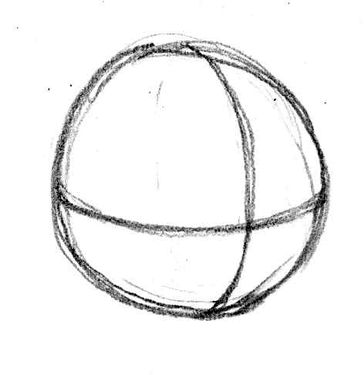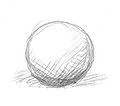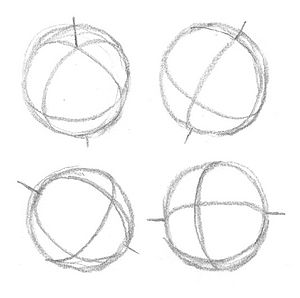Figure Drawing - 3D
From 2D to 3D
In 3D Figure Drawing, we draw a figure using 3D objects as building blocks. The most important, basic and essential object is the ball, also known as sphere.
What does a ball look like? On paper, we can only draw the projection of it, which is always the same shape no matter from which direction we look at the ball: a circle. So the circle is the most basic and important shape in drawing.
Now the problem is, when we draw a circle it doesn't really look like a ball. It could be a ball but it could also be, for example, a cup seen from above or a cylinder or a circular hole. So we need to do something that will make the circle look like a ball.
There are different options we can use to that end. We can add light and shade, for example. Or a shadow cast by the ball onto a surface. But the simplest method - and the best - is to add surface lines - lines that run along the surface of the object, like the equator and a meridian line on a globe - or like a crosshair.
Shading would be another option to turn a circle into a ball. But this is better used for finishing, not during construction.
These lines are bent. They are actually parts of an ellipse - the 2D projection of a circle. Their positions on the ball define a direction in space.
Exercise
Get a pencil (preferrably a soft to medium one, not a hard one) and a sheet of paper. Draw many circles, big and small. Don't worry if they are not evenly round. Go round and round as many times as you like, and remember to draw lightly - light enough so you could easily erase any line if you needed to.
Try to see your circles as balls. Draw a point inside a circle and try to see this point as the crosshair point of two surface lines. Then draw one surface line (remember: ellipse - the center of the ellipse is the center of the ball because it is a so-called great circle on the ball). Then draw the other surface line that crosses the first one. Think 3D. Try to see it as 3D.
Exercise 2
Do as many balls in different sizes and directions as you like. See how you can achieve any ball orientation you like. Draw additional surface lines - such as other meridians, or the poles, or other circles of latitude and see if they are helpful for you.
Draw the hidden parts of the surface lines as well (lightly) and see how this helps a) get the visible parts correct, b) to locate positions on the hidden side of the sphere as well (which might be needed sometimes as they influence other objects that are visible).
Every surface line on a sphere is a great circle in space, which when you draw it is distorted into an ellipse because you view it from an angle. But no matter what the shape of the ellipse is - wide or narrow; vertical, horizontal or diagonal: its center is always at the center of the sphere. This is because the center of any great circle coincides with the center of the sphere.
Chat rooms • What links here • Copyright info • Contact information • Category:Root




